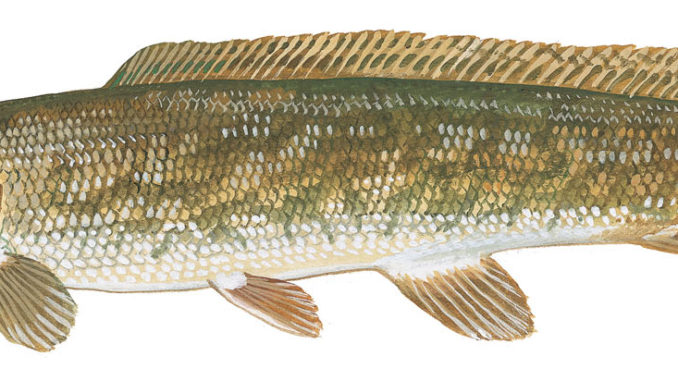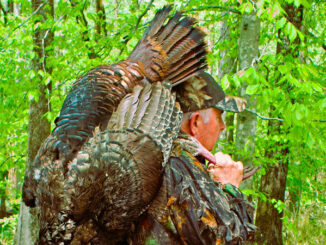
Commonly called mudfish, this ancient fish thrives in the Carolinas
The bowfin, whose more common name is mudfish, is a close relative of the gar. Its stout body and long dorsal fin, which covers almost three-quarters the length of its body, gives the fish a snaky or eel-like appearance. It has a rounded tail and can range in color from light green, dark green, to black with mottling, depending on diet and quality of the water in which it swims.
Adult males are easily identified by a distinct black spot with an orange halo at the upper section of their tail.
Mudfish are found throughout the Carolinas. Their range cover mostly the middle and eastern areas of both states. However, sporadic catches throughout the western parts of both states occur regularly enough.
Like most fish, mudfish have gills which allow them to breath under water. But they also have modified air bladders, which give them the ability to gulp air above the water’s surface. This helps them live in times of extreme drought, as they burrow into the mud to stay wet, breathing air through their bladder when other fish would die.
Large lakes, small ponds, and slow moving rivers with mud and dense vegetation are ideal habitats for mudfish. They are highly tolerant of stagnant water and are not negatively impacted by poor water quality.
Mudfish will eat just about anything
Mudfish are opportunists and very adaptable when it comes to eating preferences. When young, they eat mostly insects and tiny plankton. As adults, they eat other fish, crawfish, snakes, turtles, leeches, and even rodents.
Most anglers catch mudfish while targeting other species, especially largemouth bass. Soft plastic worms, jigs, live minnows, and even topwater lures will draw strikes from mudfish. Most anglers are happy to tussle with mudfish, which are sporty fighters when hooked. Some anglers even report targeting these fish once they know of locations they inhabit.
South Carolina’s Lowcountry Kayak Anglers, which holds a monthly contest for a certain species of fish, named mudfish as their target species in one of their contests. And a group of North Carolina anglers run the NC Bowfin Anglers Group on Facebook, promoting the pursuit of this fish.
Bowfin are some of the oldest fish on the earth
Mudfish typically spawn from March through June. Males perform the nest-building duties. They fan out nests with their tails while clearing vegetation with their mouths. Once females lay their eggs, which they usually do in the dark, males protect the nests. The males then stay with the young hatchlings as they learn to fend for themselves.
This fish is believed to be the only remaining member of a group of fish which lived almost 200 million years ago.
Mudfish are native to both Carolinas, but are sometimes misidentified as the Northern snakehead, an invasive and destructive fish.
Aside from the name bowfin, mudfish are known colloquially throughout the Carolinas by several different names. These include vampire bass, cypress bass, grindle, grinnel, dogfish, blackfish, and leather fish.
The North Carolina state record was set in 1997 with a 17-pound, 15-ounce fish that was caught in the Black River.
The South Carolina state record (21-pounds, 8-ounces) was set in Forest Lake, a community lake in Florence, S.C. by Robert Harmon in January of 1980. Harmon was trolling with a Rebel Deep Runner when the big fish hit. Harmon’s fish is also the current world record of the species.





1 Trackback / Pingback